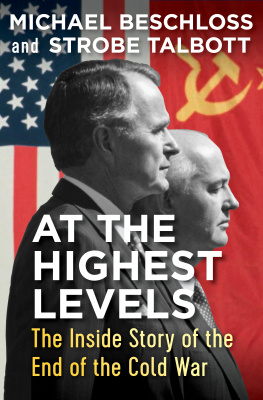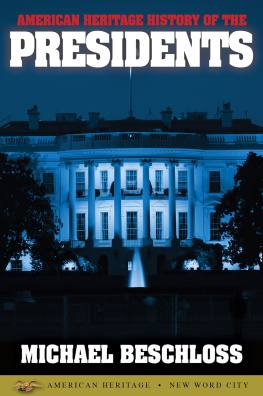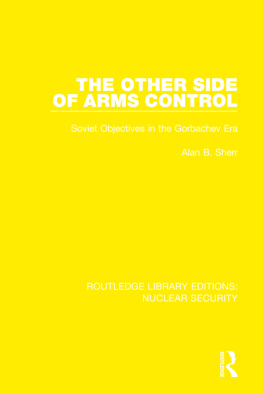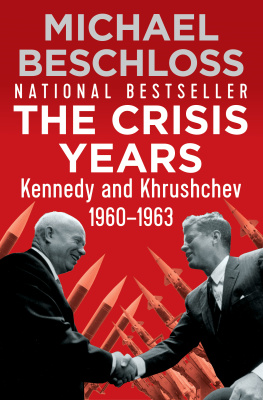PREFACE
At the beginning of 1989, we decided to write a book about relations between the United States and the Soviet Union over the next three years. No one could have foretold that our story would encompass the liberation of Eastern Europe, the disbanding of the Warsaw Pact, the suspension of the Soviet Communist party, the death of the Soviet Union, and the end of the Cold War.
The title of this book reflects its central theme: in managing the U.S.Soviet relationship during its climactic phase, George Bush and Mikhail Gorbachev relied on understandings reached at the highest levels, often in secret and in consultation with only their very closest advisers. They developed what they came to call a partnership. The term suggests how they transformed the East-West rivalry. They were able to preserve and strengthen their cooperation despite international crises and flare-ups of domestic opposition on both sides.
Still, conducting state-to-state relations in this highly personal fashion had its costs. Bush and Gorbachev were so closely attuned to each other that it eventually caused both men to lose touch with their domestic constituencies.
Gorbachev came to believe that it was more important for him to cultivate his relationship with Bush and his fellow Western leaders than to reach an accommodation with Boris Yeltsin and other champions of democratization, decentralization, and free-market economics.
Bush was so intent on shoring up Gorbachev that he was slow to perceive that by the summer of 1991, the Soviet leader was largely a spent force. Bush created the impression that he cared more about his friend in the Kremlin than about the principles of freedom and independence. His ties to Gorbachevand his reluctance to support Yeltsinultimately became a political liability in Bushs campaign for reelection.
Early in our work, we quietly asked a large number of American and Soviet officials if they would speak with us on a regular basis about what was happening within and between their two governments; many consented, on the condition that we not identify them as sources. We made similar arrangements with officials of other NATO and Warsaw Pact states.
For more than three years, we kept in frequent touch with contacts in Washington, Moscow, and several European capitals. We often saw our sources within dayssometimes even within hoursof the closed-door meetings, negotiating sessions, telephone calls, and other diplomatic exchanges described in these pages. The information they provided was not just reproduced from fresh memory but often drawn from written talking points, memoranda of conversations, reporting cables, and other documents. We have used direct quotations only when our sources had firsthand, immediate knowledge of what was said. As far as possible, we have checked information about each meeting, conversation, or episode with a variety of sources.
Just as the official written record of these events will eventually be declassified, so we are placing our research and interview notes in the Williams College Library in Williamstown, Massachusetts, under time seal for use by future scholars.
Since so many of our sources must remain anonymous, we cannot acknowledge our debt to them here, but our gratitude to them is immense.
Among those we can thank are several officials responsible for informing the public about the workings of government. In Washington: Marlin Fitzwater, the presidential press secretary, his deputy, Roman Popadiuk, and their colleagues in the White House and National Security Council staff press offices; Margaret Tutwiler of the State Department; Pete Williams of the Defense Department; Captain Jay Coupe and Colonel William Smullen of the office of the chairman of the Joint Chiefs of Staff; and E. Peter Earnest of the Central Intelligence Agency.
In the Soviet government: Vitali Ignatenko, Igor Malashenko, and Andrei Grachyov of the Kremlin; Gennadi Gerasimov of the Ministry of Foreign Affairs; and Boris Malakhov, Leonid Dobrokhotov, and Georgi Oganov of the Soviet embassy in Washington.
We also appreciate the assistance we received from the Institute for the Study of the U.S.A. and Canada, its director, Academician Georgi Arbatov, and its Washington representative, Vladimir Pechatnov.
For help in making our way through the thickets of arms control, we would like to thank Spurgeon Keeny, Jack Mendelsohn, Matthew Bunn, Dunbar Lockwood, and Lee Feinstein of the Arms Control Association in Washington.
Several editors at Time supported our efforts and guided into the pages of the magazine excerpts from our work while it was still in progress: Henry Muller, John Stacks, Ron Kriss, James Kelly, Johanna McGeary, and Brigid Forster. Michael Duffy, Dan Goodgame, Michael Kramer, and J. F. O. McAllister were generous with their counsel and the fruits of their own reporting.
We are especially grateful to Walter Isaacson, who encouraged this project from its inception and gave us an expert and detailed critique of the final manuscript.
The Moscow bureau of TimeJohn Kohan, Jay Carney, and Felix Rosenthalwere most hospitable during our frequent intrusions. Yuri Zarakhovich helped us with a variety of queries while we were finishing the book.
Several friendsnotably James MacGregor Burns, Elizabeth Drew, William Hamilton, Richard Holbrooke, Priscilla Johnson McMillan, Don Oberdorfer, and Louise Walkerprovided us with substantive advice and moral support at key moments. Two others, both masters of the subject of East-West relations, William G. Hyland and Michael Mandelbaum, read early versions of the manuscript and gave us useful comments.
We express a special debt to Maryam Mashayekhi, Martha Clark, and Galit Zolkower, who helped in gathering research material for this book and aided us in innumerable other ways. Vladislav Zubok and Kathy Lavinder provided us with additional research.
Thanks, also, to Ed Turner, Gail Evans, Bernard Shaw, Frank Sesno, Charles Bierbauer, Steve Hurst, Claire Shipman, Patrick Reap, and Jill Neff of CNN, to Newton Minow and Yvonne Zecca of the Annenberg Washington Program, and to Patricia Lee Dorff of Foreign Affairs.
We relied particularly on the professionalism of our literary agents, Timothy Seldes and Esther Newberg. Their confidence in us kept us going. We also feel very lucky to have ended up in the honorable and capable hands of Charles Hayward and William Phillips at Little, Brown and Company. Our editor there, Roger Donald, along with his colleagues Dorothy Straight and Geoffrey Kloske, saw our manuscript through to publication with great skill, high standards, and good cheer.
Finally, we are grateful to all members of our households who had to live with this project for four years. Devin and Adrian Talbott took an active interest in the subject and indulged their father in his preoccupations. Our wives, Afsaneh and Brooke, encouraged our collaboration with each other even when it strained our collaborations with them. They also read large portions of the manuscript at various stages and gave us the benefit of their excellent advice. For those and many other reasons, this book is dedicated to them.













